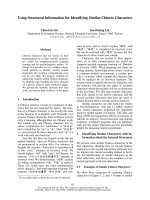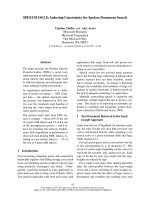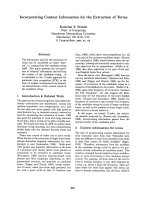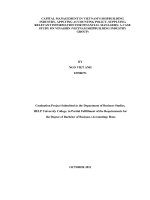24926 information for candidates document
Bạn đang xem bản rút gọn của tài liệu. Xem và tải ngay bản đầy đủ của tài liệu tại đây (1.54 MB, 16 trang )
Preliminary
English
Test for Schools
Information for Candidates
Information
for candidates
– PET for
Schools
Why take the Preliminary English Test (PET)
for Schools?
Success in the Preliminary English Test (PET) for Schools shows that you can use everyday
English at an intermediate level.
The content and topics in the test are targeted at the interests and experiences of school
children.
You are tested in reading, writing, listening and speaking.
n International recognition
PET for Schools is at Level B1 of the Common European Framework of Reference (CEFR).
Level B1 shows that the learner can, for example:
• deal with most of the situations you might meet when travelling as a tourist in an
English-speaking country
• ask simple questions and take part in factual conversations
• write letters or make notes on familiar matters.
Many universities, employers and government departments recognise PET as an
intermediate qualification in English.
You can find a full list at: www.CambridgeESOL.org/recognition
n Certificates
Learners who pass PET for Schools receive a certificate showing they have passed the
Preliminary English Test at Level B1.
Learners who show ability at the level below B1 are awarded a certificate showing they
have achieved Level A2 of the CEFR.
For more information about PET for Schools, please visit:
www.CambridgeESOL.org/PETforSchools
Why take a Cambridge ESOL test?
Cambridge ESOL is a part of Cambridge Assessment, which has over 150 years’ experience
in educational assessment.
We are committed to providing internationally recognised qualifications that help you to
achieve your life goals.
For more information about Cambridge ESOL, please visit: www.CambridgeESOL.org
ket for schools
information for candidates
2
What does PET for Schools involve?
This booklet is a brief introduction to PET for Schools. We show examples from each part
of the test, but in some cases we do not show the full text or all the questions. If you would
like to see a full sample paper for PET for Schools, you can download one from our website
at: www.candidates.CambridgeESOL.org/cs/
The table below shows the different parts of PET for Schools and how long each paper
takes. In PET for Schools, Reading and Writing are combined on one question paper.
Name of paper
Content
Time allowed
Marks (% of total)
Paper 1
Reading and Writing
Reading: 5 parts / 35 questions
1 hour 30 minutes
Reading: 25%
Writing: 25%
Paper 2
Listening
4 parts / 25 questions
about 35 minutes
(including 6 minutes’
transfer time)
25%
Paper 3
Speaking
4 parts
10–12 minutes per
pair of candidates (2:2
format*)
25%
Writing: 3 parts / 7 questions
* 2 examiners, 2 candidates (2:3 format is used for the last group in a session where necessary)
n Paper 1 Reading and Writing
Time: 1 hour 30 minutes
Reading
Part 1 (Questions 1–5)
In the first part of the Reading paper you have to read and understand different kinds
of short texts. These may be notices and signs, packaging information (for example
instructions on a food package) and communicative messages (notes, emails, cards and
postcards).
In the example below you can see two typical examples of the type of question you will
find in Part 1. Read the text and decide which is the best answer (A, B or C). In the test
there are three more questions like the ones below.
ket for schools
information for candidates
3
Part 2 (Questions 6–10)
In Part 2 you will find five descriptions of people. There are then eight short extracts on
a particular topic. This may be goods or services of some kind (for example, purchasing
books, visiting museums or choosing holidays). You have to match each person to one of
the texts.
In the examples below you have some information about two people, Olaf and Becca, and
what they like to read. There are then six texts about different magazines. You have to
decide which magazines Olaf and Becca would enjoy most. In the test there is information
about three more people and two more magazines for you.
ket for schools
information for candidates
4
Part 3 (Questions 11–20)
In Part 3 you have to read a longer, factual text and look for precise information. The texts
may be brochure extracts, advertisements in magazines or website information. Before you
read the text, there are 10 questions which are single-sentence statements about the text.
You have to decide whether each statement is correct or incorrect.
In the example below you have five sentences (11–15) about a comedy club for young
people. Read the text ‘Comedy Kids’ and then decide if each sentence is correct or
incorrect. In the test, there are five more sentences like the ones below. You mark A on
your answer sheet if the sentence is correct, and B if it is not correct.
Part 4 (Questions 21–25)
In Part 4 the text you have to read expresses opinion or attitude. There are then five
questions for you to answer. For each question we give you four possible answers (A, B, C
or D) and you have to choose the right one.
The text on the next page is about an underwater research project. Read the text and try to
answer questions 21 and 22. In the test, there are three more questions like these.
ket for schools
information for candidates
5
Part 5 (Questions 26–35)
In this part of the Reading paper, you have a short text with 10 numbered spaces. You have
to find the missing word for each space. The spaces are designed to test mainly vocabulary
but also grammatical points such as pronouns, modal verbs, connectives and prepositions.
After the text, we give you four possible answers for each numbered space and you have to
choose the right one.
On the next page is part of a text called ‘Superheroes’. There are four possible answers for
each of the first five numbered spaces (26–30). Read the answers and try to decide which is
the right missing word (A, B, C or D). In the test there are five more sets of answers like the
ones on the next page.
ket for schools
information for candidates
6
Writing
Part 1 (Questions 1–5)
There are five questions to answer in Part 1 of the Writing paper. For each question, you
have one sentence which is complete and a second sentence which has a missing word
or words. You have to complete the second sentence with between one and three words
so that it means the same as the first sentence. All five sentences share a common theme
or topic.
In the example below, there are some sentences about playing basketball (1–3). For each
question, read the first sentence and then try to find the missing word(s) to complete the
second sentence. Remember that the second sentence must have the same meaning as
the first one. In the test there are two more questions like the ones below.
ket for schools
information for candidates
7
Part 2 (Question 6)
For Part 2 you have to write a short, communicative message of between 35 and 45
words. The instructions in the question tell you who you are writing to and why you are
writing. There are also three bullet points which tell you the content you must include
in your answer. Remember to read the instructions carefully and plan your answer to
cover everything.
In the example below you have to write a card to your British friend, Sam.
Part 3 (Question 7 or 8)
In Part 3 you can choose to write either an informal letter or a story. You should write
about 100 words.
For the letter, you have to read an extract of a letter from a friend of yours and you then
have to write a reply to your friend. The letter from your friend will tell you what to write
about. For the story, we give you either a short title or the first sentence of the story.
In the two examples on the next page, you either have to write to your friend about a
special day that people celebrate in your country, or write a story beginning with the
sentence that is given.
ket for schools
information for candidates
8
ket for schools
information for candidates
9
n Paper 2 Listening
Time: approx. 35 minutes including 6 minutes’ transfer time
Part 1 (Questions 1–7)
In this part of the test, there are seven short listening texts taken from daily life. These
may be conversations at home or between friends, radio announcements, parts of talks,
exchanges in shops, etc. For each text there is a question and three pictures. You have to
listen to the recording and choose the picture which best answers the question.
Below we give you two examples of typical questions. Read each question and look at the
pictures to get an idea of the kind of conversations which are on the recording and the
information you will need to listen for. You have to choose the right answer (A, B or C). In
the test, there are five more questions like the ones below.
Part 2 (Questions 8–13)
In Part 2 you have to listen to a longer recording which may be either a monologue, or an
interview with questions from a radio presenter. You hear the recording twice. There are
then six multiple-choice questions with three possible answers for each one.
In the example on the next page, the recording is an interview with a girl called Sally
Myers whose first book has been recently published. You have to listen and choose the
right answer (A, B or C) for each question. In the test, there are three more questions like
the ones on the next page.
ket for schools
information for candidates
10
Part 3 (Questions 14–19)
The recording for Part 3 is also a longer text. This may be a radio announcement or a
recorded message which gives information about places and events. Sometimes it is a talk
or a radio programme, in which people are talking about courses, trips or holiday activities.
You will hear the recording twice. On the question paper you will find a page of notes
summarising the content of the text. Six pieces of information are missing from the notes
and you have to listen to the recording, find the correct information and write it in the
numbered gaps.
In the example on the next page, the recording is some information about a film-making
competition. There are six spaces (14–19) where information is missing. You have to listen
to the recording and write down the correct information in each space.
ket for schools
information for candidates
11
Part 4 (Questions 20–25)
In Part 4 you will hear a recording of two people talking. It’s an informal conversation
about everyday topics and the two people will talk about their opinions and agree or
disagree on certain points. There are then six statements and you have to decide whether
each statement is right or wrong.
In the example below, Michelle and Antony are talking about a television programme
called ‘Pop Choice’. You have to read the statements and decide whether each one is right
(A) or wrong (B). In the test, there are three more statements like the ones below.
At the end of the paper-based version of the Listening test, you have 6 minutes to transfer
your answers to the answer sheet.
ket for schools
information for candidates
12
n Paper 3 Speaking
Time: 10–12 minutes per pair of candidates
For the Speaking test there are two oral examiners and you take the test in a pair with
another candidate. At centres with an uneven number of candidates, the last single
candidate is examined with the last pair in a group of three. The Speaking test is worth
25% of the total marks.
Part 1
The first part of the test is a general conversation. One of the examiners will talk to each
of you in turn and will ask you for personal details, about your daily routines, likes and
dislikes, etc. The examiner will ask you at some point to spell all or part of your name.
Part 2
In Part 2 you have to take part in a simulated situation with the other candidate. For
example, you may have to make and respond to suggestions, discuss alternatives, make
recommendations and negotiate agreement with your partner.
To help you with this part of the test, the examiner will give you a prompt sheet like the
one below and give you some instructions. In this case, the examiner will tell you that a
boy is leaving his school because his parents are going to work in another country. You
have to talk together about the different presents the students in his class could give him
and then decide which would be best.
Part 3
For Part 3 the examiner will give you a colour photograph like the one on the next page.
You have to describe what you can see in the photograph. The examiner then gives your
partner a different colour photograph to describe.
ket for schools
information for candidates
13
Part 4
In this last part of the test, you have to talk with your partner. The examiner will give you
a subject which is related to the two photographs you described in Part 3. In this case, the
subject is bedrooms at home. The examiner asks you to talk about the kinds of things you
have in your bedroom now and the things you’d like to have in your bedroom in the future.
ket for schools
information for candidates
14
Preparing for PET for Schools
If you would like more practice material to help you prepare for PET for Schools, there are
past paper packs available to buy which include an audio CD of the Listening test. You can
find more information, prices and details on our website at:
www.CambridgeESOL.org/resources/past-papers.html
Next steps
We wish you every success in taking PET for Schools and we hope that you will take other
Cambridge ESOL tests in the future. The First Certificate in English (FCE) is the next level of
Cambridge exams. You can find more information about FCE on our website at:
www.CambridgeESOL.org/FCE
ket for schools
information for candidates
15
Companies
who recognise
Cambridge
ESOL exams
3M
Hertz
Adidas
Hewlett-Packard
Agfa-Gevaert
HSBC
AstraZeneca
IBM
AT&T
Johnson & Johnson
Barclays Bank
KPMG
BASF
Microsoft
Bayer
Mobil Oil
BP
Nestlé
British Airways
Nokia
Cable & Wireless
PepsiCo
Carrefour
Philips
Citibank
PricewaterhouseCoopers
Coca-Cola
Procter & Gamble
Colgate-Palmolive
Rank Xerox
Credit Suisse
Roche
DaimlerChrysler
Rolls-Royce
Dell
Shell
Deutsche Bank
Siemens
DHL
Sony
Disney
Sun Microsystems
DuPont
Texaco
Ericsson
Toyota
Estée Lauder
Unilever
General Motors
Vodafone
Gillette
World Bank
GlaxoSmithKline
World Health Organization (WHO)
Goodyear
World Wide Fund for Nature (WWF)
For a full list of companies and educational institutions who recognise PET,
please visit our website at:
www.CambridgeESOL.org/recognition
www.CambridgeESOL.org/PET
University of Cambridge
ESOL Examinations
1 Hills Road
Cambridge
CB1 2EU
*0061889780*
United Kingdom
Tel.
+44 1223 553355
Fax.
+44 1223 460278
© UCLES 2009 EMC | 5985 | 9Y06
NOT FOR RESALE
ket for schools
information for candidates
16









